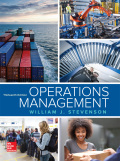
EBK OPERATIONS MANAGEMENT
13th Edition
ISBN: 8220103675987
Author: Stevenson
Publisher: YUZU
expand_more
expand_more
format_list_bulleted
Concept explainers
Question
Chapter 18, Problem 10P
a.
Summary Introduction
To determine: The probability that a machine will have to wait for an adjustment.
b.
Summary Introduction
To determine: The average number of machines waiting for adjustment.
c.
Summary Introduction
To determine: Average number of machines being serviced (H).
d.
Summary Introduction
To determine: Expected hourly output of each machine, taking adjustments into account.
e.
Summary Introduction
To determine: Optimum number of operators.
Expert Solution & Answer
Want to see the full answer?
Check out a sample textbook solution
Students have asked these similar questions
10. Two operators handle adjustments for a group of 10 machines. Adjustment time is exponentiallydistributed and has a mean of 14 minutes per machine. The machines operate for an average of86 minutes between adjustments. While running, each machine can turn out 50 pieces per hour.Find the following:a. The probability that a machine will have to wait for an adjustmentb. The average number of machines waiting for adjustmentc. The average number of machines being servicedd. The expected hourly output of each machine, taking adjustments into accounte. Machine downtime represents a cost of $70 per hour; operator cost (including salary andfringe benefits) is $15 per hour. What is the optimum number of operators?
2. A repair and inspection facility consists of two stations: a repair station with two technicians, and
an inspector station with 1 inspector. Each repair technician works at the rate of 3 items per hour; the
inspector can inspect 8 items per hour. Approximately 10% of all items fail inspection and are sent back
to the repair station. (This percentage holds even for items that have been repaired two or more times.) If
items arrive at the rate of 5 per hour, what is the long-run expected delay that items experience at each of
the two stations, assuming a Poisson arrival process and exponentially distributed service times? What is
the maximum arrival rate that the system can handle without adding personnel?
A queuing model which follows the M/M/1 assumptions has λ = 2 and μ = 3. The average waiting time in the system is
Chapter 18 Solutions
EBK OPERATIONS MANAGEMENT
Ch. 18 - Prob. 1DRQCh. 18 - Why do waiting lines form even though a service...Ch. 18 - Prob. 3DRQCh. 18 - Prob. 4DRQCh. 18 - What approaches do supermarkets use to offset...Ch. 18 - Prob. 6DRQCh. 18 - Prob. 7DRQCh. 18 - Prob. 8DRQCh. 18 - Prob. 9DRQCh. 18 - Prob. 1TS
Ch. 18 - Prob. 2TSCh. 18 - Prob. 3TSCh. 18 - Prob. 1CTECh. 18 - Prob. 2CTECh. 18 - Prob. 3CTECh. 18 - The owner of Eat Now Restaurant implemented an...Ch. 18 - Prob. 5CTECh. 18 - Prob. 1PCh. 18 - Prob. 2PCh. 18 - Prob. 3PCh. 18 - Prob. 4PCh. 18 - Prob. 5PCh. 18 - Prob. 6PCh. 18 - Prob. 7PCh. 18 - Prob. 8PCh. 18 - Prob. 9PCh. 18 - Prob. 10PCh. 18 - Prob. 11PCh. 18 - Prob. 12PCh. 18 - Prob. 13PCh. 18 - Prob. 14PCh. 18 - Prob. 15PCh. 18 - A priority waiting system assigns arriving...Ch. 18 - Prob. 17PCh. 18 - Prob. 18PCh. 18 - Prob. 1CQ
Knowledge Booster
Learn more about
Need a deep-dive on the concept behind this application? Look no further. Learn more about this topic, operations-management and related others by exploring similar questions and additional content below.Similar questions
- At a book store, one customer arrives every 4 minutes. The bookstore has one cashier, and it takes 3 minutes to serve one customer with a standard deviation of 4.9. The arrival process has a standard deviation of 7. What is the average number of customers in the queuearrow_forwardA queuing model that follows the M/M/1 assumptions has λ = 2 and μ = 8. The average number in the system Ls is ________ and the utilization of the system is ________.arrow_forwardDo: 12-21 Truck drivers working for Juhn and Sons (see Problems 12-19 and 12-20) are paid a salary of $20 per hour on average. Fruit loaders receive about $12 per hour. Truck drivers waiting in the queue or at the loading gate are drawing a salary but are productively idle and unable to generate revenue during that time. What would be the hourly cost savings to the firm associated with employing two loaders instead of one? Not this: 12-19 Juhn and Sons Wholesale Fruit Distributors employs one worker whose job is to load fruit on outgoing company trucks. Trucks arrive at the loading gate at an average of 24 per day, or 3 per hour, according to a Poisson distribution. The worker loads them at a rate of 4 per hour, following approximately the exponential distribution in service times. Not this: 2-20 Juhn believes that adding a second fruit loader will substantially improve the firm’s efficiency. He estimates that a two-person crew, still acting like a single-server system, at the loading…arrow_forward
Recommended textbooks for you
 Practical Management ScienceOperations ManagementISBN:9781337406659Author:WINSTON, Wayne L.Publisher:Cengage,
Practical Management ScienceOperations ManagementISBN:9781337406659Author:WINSTON, Wayne L.Publisher:Cengage,

Practical Management Science
Operations Management
ISBN:9781337406659
Author:WINSTON, Wayne L.
Publisher:Cengage,